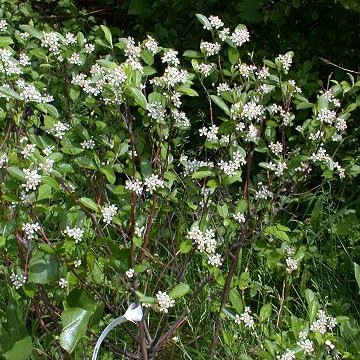

Aronia arbutifolia - (image 1 of 7)
Taxonomy
Family: Rosaceae
This genus has a rich taxonomical history. The chokeberries were originally included in the genus Pyrus L. (pears). Some authors now put this species in the genus Photinia Lindl. and regard this species as Photinia pyrifolia (Lam.) Robertson & Phipps. In the narrow sense, Photinia includes about 60 southeastern Asian and Central American species (Campbell et al. 2007). This inclusion was based on a paper by Roberston et al (1991), and I have included the relevant passage below regarding the classification of Aronia.
"The flowers and fruits of Aronia are indistinguishable from those of Photinia, and Aronia is here included within Photinia. In the cladogram in Phipps et al. (this symposium), Photinia, Aronia, and Stranvaesia form one clade. Aronia is often characterized by the presence of glands along the upper midrib of the leaves, but this feature is found in many Maloideae, including other species of Photinia, Malus, Pyrus, Eriolobus, Aria, Chamaemespilus, Docyniopsis, and Docynia as well as along the rachis of Sorbus, Cormus, and Osteonzeles" (Robertson et al, 1991).
It is worth noting that at the time of that publication there were no published hybrids between Aronia and Photinia or Stranvaesia. Hybrids have been made between Aronia and Sorbus, and at least one author has included Aronia in Sorbus in the past. Recent phylogenetic analysis of the family Rosaceae fails to lend support to the inclusion of Aronia with Photinia. The subtribe Pyrinae (pome fruits) includes all members of subfamily Maloideae in addition to the closest relatives of pome-bearing plants; three small, New World, dry-fruited genera: Kageneckia, Lindleya and Vauquelinia (Potter et al. 2007).
Campbell et al (2007) found no support of a clear relationship between Aronia, Chaenomeles, Osteomeles, Photinia, and Pyracantha. Molecular data failed to place Aronia and Photinia together or even near one another on a phylogenetic tree. They therefore recommend maintaining the genus Aronia until more data is available.
Habitat
Bogs, swamps, wet woods. Tolerant of dry, sandy soil.
Associates
Distribution
Newfoundland south along the costal plain to FL and TX, and also inland to KY and WV in mountains.
Morphology
Colonial shrub. Leaves simple, alternate, serrate, with a row of dark glands along the midvein on the upper side. Flowers white, 5-merous. Fruit a small red pome.
Notes
Flowers April to July
Fruit September to November
Wetland Indicator: Facultative Wetland
Red chokeberry is an ornamental shrub and has become increasingly popular in the landscape. Some cultivars have good red fall color. The fruiting effect is similar to that of Winterberry Holly (Ilex verticillata). Aronia is the only shrub in the northeastern US with small black glands along the midvein of the upper surface of the leaf.
Works Cited
Campbell CS, Evans RC, Morgan DR, Dickinson TA, and Arsenault MP. 2007. Phylogeny of subtribe Pyrinae (formerly the Maloideae, Rosaceae): Limited resolution of a complex evolutionary history.
Plant Systematics and Evolution:.266: 119–145
Potter D, Eriksson T, Evans RC, Oh S, Smedmark JEE, Morgan DR, Kerr M, Robertson KR, Arsenault M, Dickinson TA, and Campbell CS. 2007. Phylogeny and classification of Rosaceae.
Plant Systematics and Evolution:.266: 5-43
Robertson KR, Phipps, JB, Rohrer JR, and Smith PG. 1991. A Synopsis of Genera in Maloideae (Rosaceae).
Systematic Botany: 16(2), 376-394
Other References
Gleason, Henry A.
and A. Cronquist. 1991. Manual of Vascular Plants of Northeastern United States
and Adjacent Canada. Second Ed.
The New York Botanical Garden. Bronx, NY
Swink, F. and G.
Wilhelm. 1994. Plants of the Chicago Region.
Indiana Academy of Science. The Morton Arboretum. Lisle, Illinois.
|
© Michael Hough 2004 |